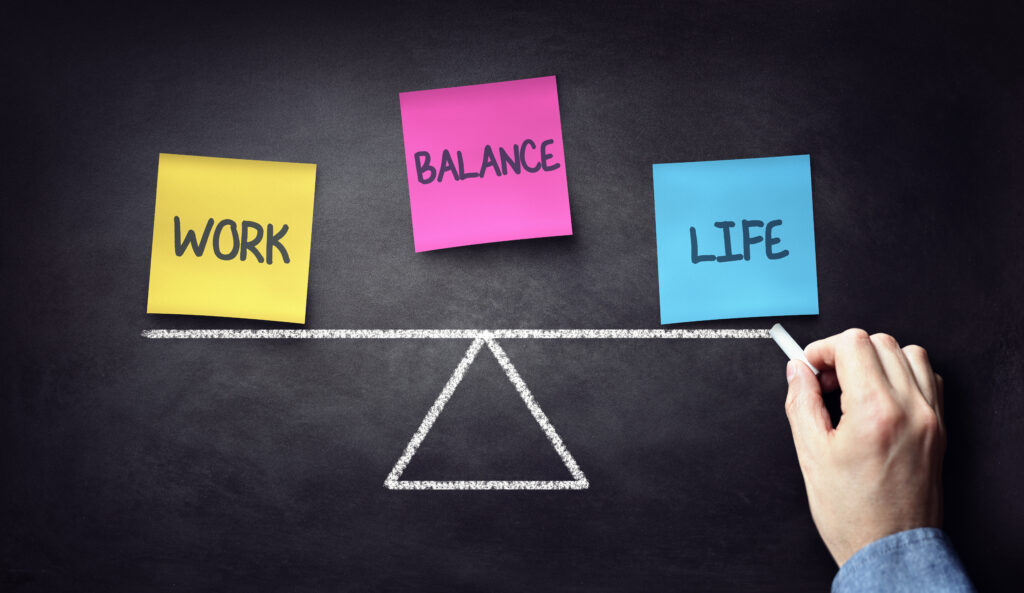

Work/Life Balance in the Digital Age

We live in a digital age where it’s now easier than ever to leave the office and continue working from almost anywhere. But the ability to stay connected and productive has introduced a whole new dilemma: creating and maintaining a healthy balance between our work and home lives.
Work/life balance is a phrase that is frequently tossed around, and one that HR professionals confront time and again. While balancing life and work was once a fairly simple concept, as staff members left their jobs behind when they went home, technology has made it possible to stay in work mode for far longer than the average 9-5 timeframe.
People’s phones are pinging after hours. They’re answering emails, taking phone calls, doing research and more; all during the time when they should be winding down and spending quality time off the clock.
The constant connection and lack of limitations puts many in the dreaded burn-out zone. This not only makes for miserable employees (and their families) but reduces productivity and results in more absences and sick days. Quite simply, we are seeing people having to call in sick to make up for the time when they should have been resting. And due to the scale of the issue, there are now frequent examples of legislation to protect employees from having to constantly be on the clock, setting the standard for HR departments and addresses potential issues before they start.
Work/life balance and legislation
While many countries leave policies up to the individual company, others are putting laws in force to ensure employees are extended the much-needed balance they need to stay sane.
In France, larger companies (those with more than 50 employees), must give employees the right to disconnect. This means they don’t have to answer emails outside of regular office hours, allowing employees to relax at home. The country also has a 35-hour work week and prohibits working shifts in non-necessary roles between 9 pm and 6 am. The law has been upheld on a number of occasions, including fining Apple in 2013 for forcing workers to work overnight.
Germany forbids managers from reaching out to staff while they are on vacation. In fact, vehicle manufacturer Daimler offers their employees software that will actually delete any incoming work emails while on vacation. The program sends a notice to the sender and if it is an urgent matter, lets them know whom to contact instead of the employee on vacation.
Sweden, Denmark, Norway, Finland, and Iceland all have laws that require a minimum of 25 paid vacation days each year; in addition to public holidays. They also have a maximum work week of 48 hours. While that’s the maximum, most countries report lower work hours. For example, in Denmark, the average employee works 32.1 hours a week, while Finland reports an average of 36.2 hours a week.
The economic consequences of the Nordic laws are astonishing. Since employees tend to be better rested and happier when they have time to relax, they are more productive; and in turn, companies worldwide have found that offering a family friendly workplace attracts more qualified candidates. In a recent US study, 88% of workers said they would take a lower paying job with flexible hours over a higher paying position with other types of benefits. This makes it clear that workers are not only savvy enough to understand the concept, but also so concerned about digital overspill that they are willing to sacrifice other perks in order to maintain a healthy balance.
Developing company policy that encourages healthy balance
Fostering and enforcing a positive balance in the digital age often falls on HR. Designing and developing a policy that clearly spells out expectations means taking a careful look at how putting in extra hours can be avoided. It’s also important to remember that for non-exempt employees (those paid hourly wages), unpaid overtime can cost you and drag you into litigation. So it isn’t just a matter of fostering healthy work habits to avoid burnout – a well crafted policy will also protect you from a legal standpoint.
Best practices include but are not limited to:
- Define work hours. Specify the number of daily hours expected from both salaried and hourly employees.
- Define communication hours. Specify the time periods in which employees can normally be expected to be available and respond to incoming messages or requests.
- Encourage and enforce digital downtime. Specify which times employees should disconnect from devices – during lunch breaks or at determined times of the day. You can also recommend healthy actions during this time, such as meditation, stretching or a walk outside.
- Enforce vacation days. Communicate to staff the need to use their paid time off or take days off throughout the year.
Some of these guidelines may need to be monitored and actioned in different cases, especially if you’re dealing with employees under pressure or with imminent deadlines. It’s a good idea to ask whether burnout and work/life balance play a part in any employee wellbeing issues.
Tying It All Together
Promoting work/life balance is an essential part of HR, and consciousness of its importance is key to any organization. Gone are the days when a good work ethic involved staying late at the office or sending emails after hours to prove you were willing to go the extra mile. Today’s companies are moving toward smarter, more holistic ways of guiding employees to their full potential and this involves ensuring there’s enough time to enjoy a fulfilling persona life as well.